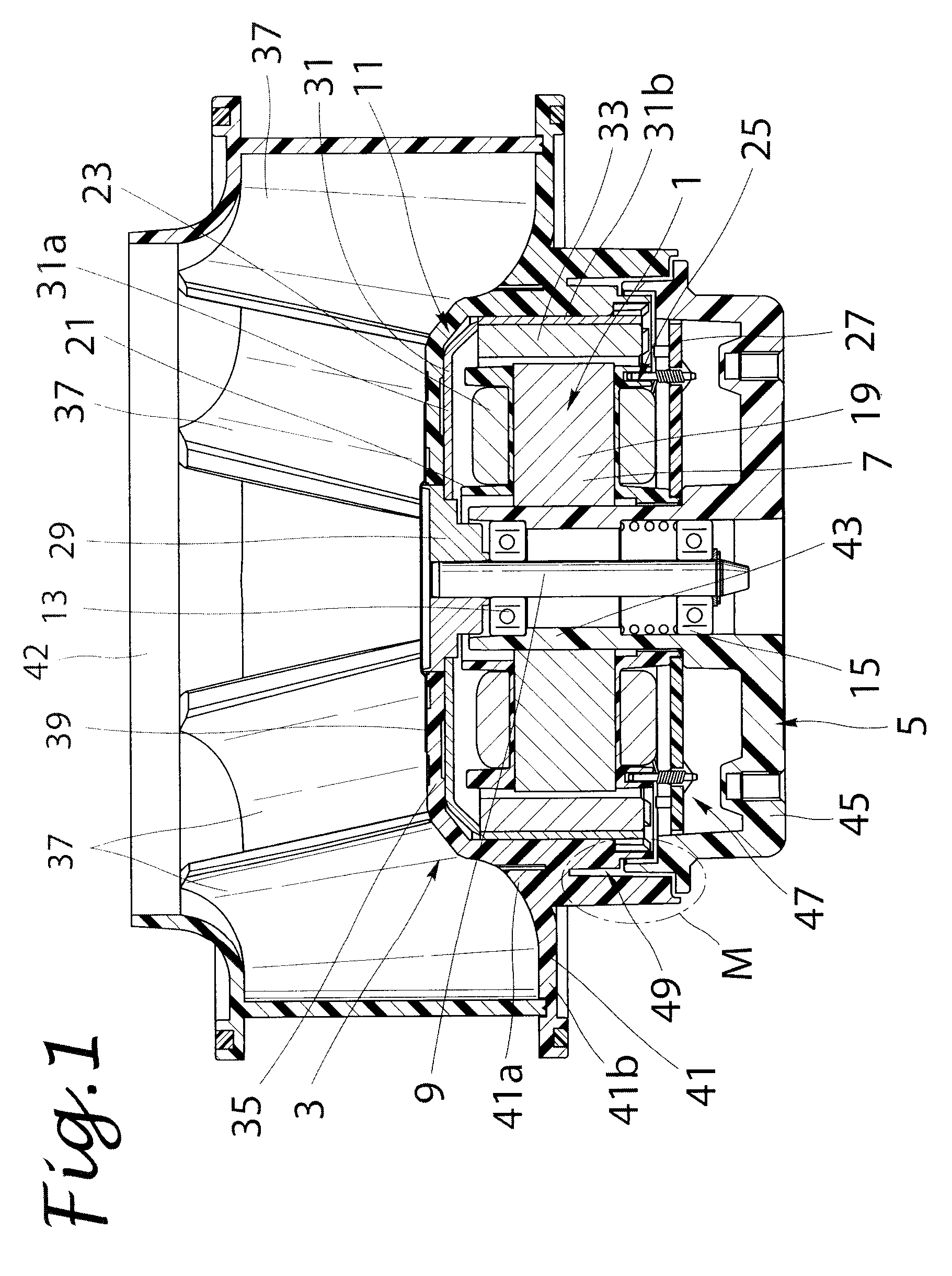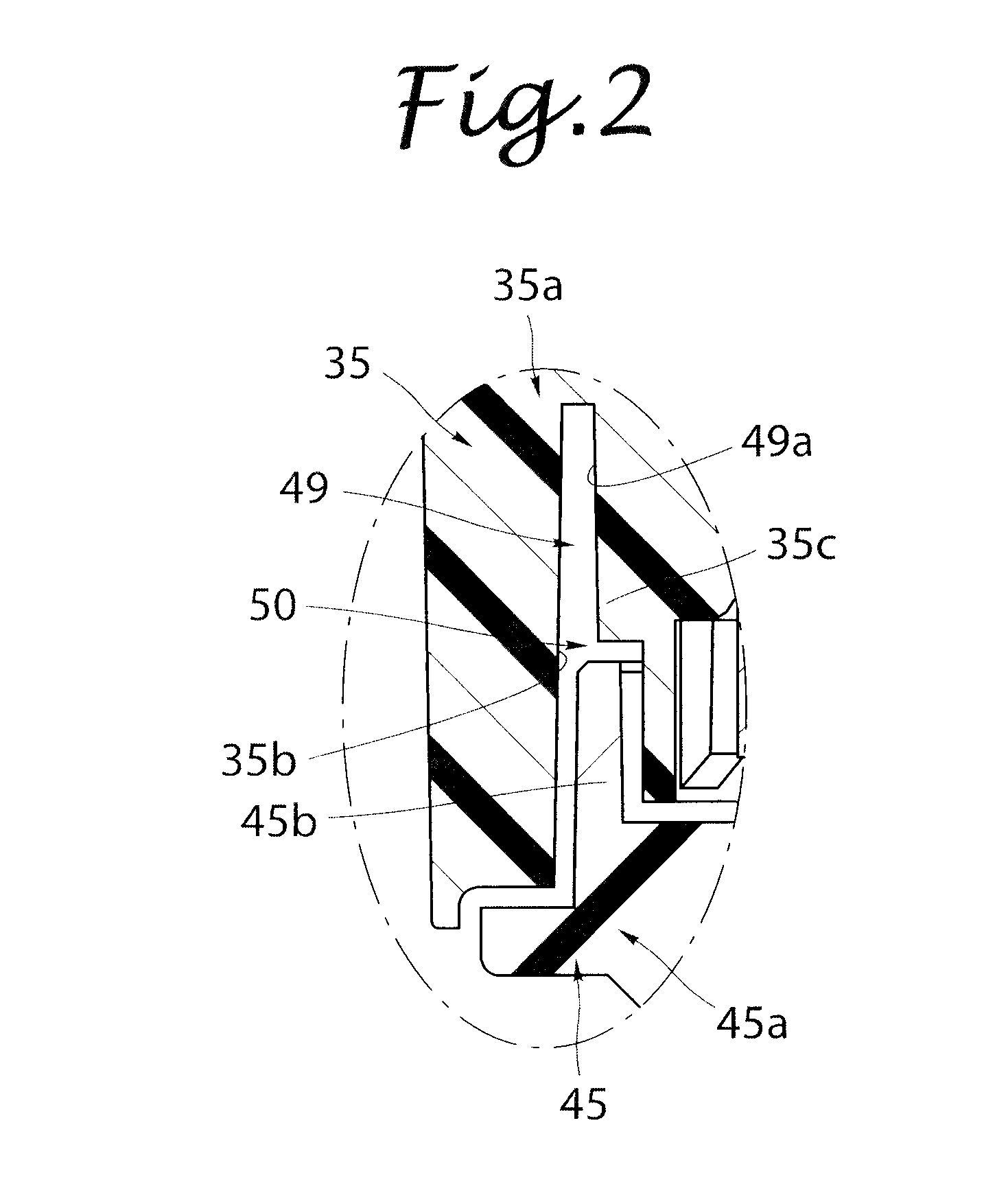Electric fan
a technology of electric fans and fans, applied in the direction of positive displacement liquid engines, piston pumps, liquid fuel engines, etc., can solve the problem of limiting and achieve the effect of enhancing the waterproof performance of conventional structures
- Summary
- Abstract
- Description
- Claims
- Application Information
AI Technical Summary
Benefits of technology
Problems solved by technology
Method used
Image
Examples
first embodiment
[0021]Embodiments of the present invention will be described below in detail with reference to the drawings. FIG. 1 is a sectional view of an electric fan in the present invention applied to a centrifugal fan. FIG. 2 is a partially enlarged view of a portion indicated by reference sign M in FIG. 1. The electric fan of this embodiment comprises an electric motor 1, an impeller 3 made of a synthetic resin and configured to be rotated by the electric motor 1, and a casing 5 for partially receiving components of the electric motor 1. The electric motor 1 includes a stator 7 and a rotor 11 configured to rotate outside the stator 7, centering on a rotary shaft 9. The stator 7 is mounted on a bearing holder 43 in which two ball bearings 13 and 15 for rotatably supporting the rotary shaft 9 are fitted and held. The stator 7 comprises a stator core 19 disposed outside this bearing holder 43, an insulator 21 made of an insulating resin and fitted with the stator core 19, and stator windings 2...
second embodiment
[0027]FIG. 3 is a sectional view of an electric fan in the present invention applied to a centrifugal fan. FIG. 4 is a partially enlarged view of a portion indicated by reference sign M shown in FIG. 3. Though dimensions and shapes of respective members of the electric fan in this embodiment are different from those of the corresponding members in the electric fan shown in FIGS. 1 and 2, the electric fan of this embodiment has basically the same structure as the electric fan shown in FIGS. 1 and 2 except a cup-like member, a base of a casing, and an impeller body. Therefore, reference numerals calculated by adding 100 to the reference numerals in FIGS. 1 and 2 are assigned to members in FIGS. 3 and 4 which have basically the same structures as those in FIGS. 1 and 2. Descriptions of the members in FIGS. 3 and 4 will thereby be omitted.
[0028]As shown in FIG. 3, the electric fan in this embodiment does not include the cup-like member fixed to the rotary shaft. Rotor magnetic poles 133...
third embodiment
[0031]FIG. 5 is a sectional view of an electric fan in the present invention applied to a centrifugal fan. FIG. 6 is a partially enlarged view of a portion indicated by reference sign M in FIG. 5. Though dimensions and shapes of respective members are different from those of the corresponding members in FIGS. 1 and 2, the electric fan of this embodiment has basically the same structure as the electric fan shown in FIGS. 1 and 2 except the configuration of a groove portion for expanding a clearance. Therefore, reference numerals calculated by adding 200 to the reference numerals in FIGS. 1 and 2 are assigned to members in FIGS. 5 and 6 which have basically the same structures as those in FIGS. 1 and 2. Descriptions of the members in FIGS. 5 and 6 will thereby be omitted.
[0032]In the electric fan of the first embodiment shown in FIGS. 1 and 2, the wall portion 35c of the impeller body 35 located radially inside of the annular groove portion 49a constituting the volume expanding portio...
PUM
 Login to View More
Login to View More Abstract
Description
Claims
Application Information
 Login to View More
Login to View More - R&D
- Intellectual Property
- Life Sciences
- Materials
- Tech Scout
- Unparalleled Data Quality
- Higher Quality Content
- 60% Fewer Hallucinations
Browse by: Latest US Patents, China's latest patents, Technical Efficacy Thesaurus, Application Domain, Technology Topic, Popular Technical Reports.
© 2025 PatSnap. All rights reserved.Legal|Privacy policy|Modern Slavery Act Transparency Statement|Sitemap|About US| Contact US: help@patsnap.com



